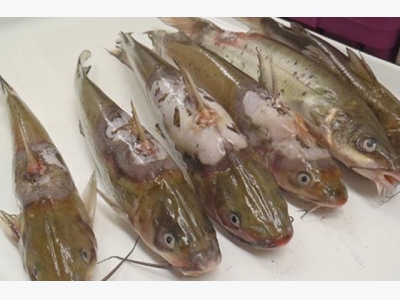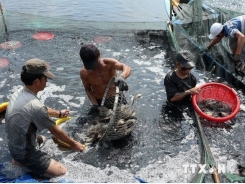Auburn develops vaccine to fight costly catfish disease

These channel catfish are infected with columnaris, a common aquatic disease for which Auburn University researchers are developing a vaccine. Auburn University.
Columnaris disease can affect nearly all freshwater fish species and causes millions of dollars in annual losses in the catfish industry alone.
Auburn University researchers in Alabama will use an almost $321,000 U.S. Department of Agriculture grant to field-test a novel vaccine that would effectively and economically control one of the most serious bacterial infections in the aquaculture industry today.
Columnaris disease can affect nearly all freshwater fish species and causes millions of dollars in annual losses in the catfish industry alone. The sole columnaris vaccine currently available is only moderately effective, but Auburn researchers have been working on an improved immunization using bacteria derived from a highly virulent strain of the disease, the university said.
In laboratory tests, the experimental vaccine that Auburn fisheries, aquaculture and aquatic sciences professor Cova Arias has developed and patented has outperformed the vaccine now on the market, the announcement said.
“At this point in our research, we need data on a larger scale to successfully commercialize the vaccine,” Arias said. “We will use this most recent grant to fulfill our gap of information.”
Arias was awarded the competitive grant in November through the Aquaculture Research Program, which is administered by USDA’s National Institute of Food & Agriculture. The research program funds projects that support the development of environmentally and economically sustainable aquaculture in the U.S.
Columnaris, caused by the bacterium Flavobacterium columnare, affects a number of warmwater species, Arias said.
“If you’ve ever had a goldfish die, it probably died from this disease,” she said. “It affects ornamental species, catfish, tilapia and trout, and it is distributed worldwide.”
For catfish farmers, fish diseases can be economically devastating, and columnaris bacteria is one of the three main disease-causing pathogens.
“In some years, columnaris is the number-one disease problem in catfish production, and in other years, it’s number two, depending on the individual farm and the season,” Arias said. “In hatcheries, disease can kill 90-100% of the fish. When fish are sick and fighting a pathogen, they won’t eat properly, so an effective vaccine can increase survival and growth performance.”
The Auburn vaccine has outperformed the commercial vaccine in all experiments conducted to date, reducing cumulative mortality two to four times better than the existing vaccine, the university reported. In vaccine trials of Nile tilapia and catfish, the vaccine increased survival rates by 66% and 17%, respectively, over the currently available vaccine.
It’s a proven vaccine in the lab, but there are many more variables at play on a larger scale.
The first objective of the newly funded research is to identify the best methods for administering and storing the vaccine.
“Our formula now is administered by bath or immersion, and that’s easy to do when fish are small and are transferred from the hatchery to the farms,” Arias said. However, “the best immunization method is to wait until the fish are mature and then boost them a couple of months before the disease shows up.
“We know columnaris peaks in mid- to late spring and then again in early fall, so ideally, you could give fish a boost a couple of months before temperatures rise,” she said. “The best way to do that is to add the vaccine to the feed.”
Vaccine storage is also a critical area. “The commercial vaccine currently available is a modified live vaccine that has to be kept frozen,” Arias said. “We have developed some storage solutions, or buffers, that, based on the data, will allow us to store the vaccine at room temperature.”
This will help make the vaccine more cost effective and readily available to farmers, she said.
The next objective is to move the vaccine into the field and conduct controlled experiments in ponds.
“We’re taking fish from 10-20 gal. tanks in the lab to a 10th-of-an-acre pond,” Arias said. “It still will be relatively controlled conditions, but we’ll do side-by-side comparisons between our vaccine and the commercial vaccine.”
Lab experiments are continuing this year and will move into the field in 2019, she said.
“We completed the safety studies on the vaccine, and we know it is safe and stable,” Arias said. “We’ve checked all the USDA ‘boxes,’ but we still have to prove it works in field conditions. We’ll continue adjusting the formula and the delivery.”
The project’s third goal will be a collaboration with Auburn fisheries professor Terry Hanson, an aquacultural economist who will conduct an economic analysis and economic feasibility study of the vaccine in comparison with the commercial vaccine.
Arias said there has been an interest in the vaccine among aquatic health companies.
“Ideally, a commercial entity will take it from there,” she said. “Then, the company will either contract it out or make the vaccine itself. Or, if no companies are interested, we may be able to work directly with farmers and produce a vaccine for them. Realistically speaking, we’re probably looking at making it available to farmers in the next five years.”
Có thể bạn quan tâm
Phần mềm

Phối trộn thức ăn chăn nuôi

Pha dung dịch thủy canh

Định mức cho tôm ăn

Phối trộn phân bón NPK

Xác định tỷ lệ tôm sống

Chuyển đổi đơn vị phân bón

Xác định công suất sục khí

Chuyển đổi đơn vị tôm

Tính diện tích nhà kính

Tính thể tích ao hồ



 Spain and Portugal to propose management plan for…
Spain and Portugal to propose management plan for…  Use of Industry 4.0 technologies in aquaculture discussed
Use of Industry 4.0 technologies in aquaculture discussed